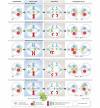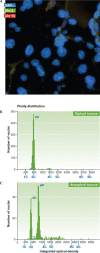Cancer chromosomal instability: therapeutic and diagnostic challenges - PubMed (original) (raw)
Review
Cancer chromosomal instability: therapeutic and diagnostic challenges
Nicholas McGranahan et al. EMBO Rep. 2012.
Abstract
Chromosomal instability (CIN)-which is a high rate of loss or gain of whole or parts of chromosomes-is a characteristic of most human cancers and a cause of tumour aneuploidy and intra-tumour heterogeneity. CIN is associated with poor patient outcome and drug resistance, which could be mediated by evolutionary adaptation fostered by intra-tumour heterogeneity. In this review, we discuss the clinical consequences of CIN and the challenges inherent to its measurement in tumour specimens. The relationship between CIN and prognosis supports assessment of CIN status in the clinical setting and suggests that stratifying tumours according to levels of CIN could facilitate clinical risk assessment.
Conflict of interest statement
The authors declare that they have no conflict of interest.
Figures
Figure 1
Numerical and structural chromosomal instability. Scheme showing whole chromosome gains and losses (numerical CIN) and sub-chromosomal gains, losses, inversions and translocations (structural CIN).
Figure 2
Mechanisms of chromosome missegregation in mitosis. (A) A wild-type division, producing identical daughter cells. (B–E) Mitotic errors that result in aneuploid daughter cells.
Figure 3
Direct methods to assess tumour CIN status. (A) Section from a renal cell carcinoma biopsy, hybridized to two fluorescently labelled centromere probes—chromosome 2 (green) and chromosome 15 (red). Variation in centromere copy number is evident between the nuclei. (B) DNA image cytometry profile for a diploid tumour (diploid DNA content determined relative to control diploid cells). (C) DNA image cytometry profile for an aneuploid tumour (determined relative to control diploid cells).
Nicholas McGranahan
Rebecca A Burrell
David Endesfelder
Marco R Novelli
Charles Swanton
Similar articles
- Quantifying chromosomal instability from intratumoral karyotype diversity using agent-based modeling and Bayesian inference.
Lynch AR, Arp NL, Zhou AS, Weaver BA, Burkard ME. Lynch AR, et al. Elife. 2022 Apr 5;11:e69799. doi: 10.7554/eLife.69799. Elife. 2022. PMID: 35380536 Free PMC article. - Chromosomal instability: A common feature and a therapeutic target of cancer.
Tanaka K, Hirota T. Tanaka K, et al. Biochim Biophys Acta. 2016 Aug;1866(1):64-75. doi: 10.1016/j.bbcan.2016.06.002. Epub 2016 Jun 21. Biochim Biophys Acta. 2016. PMID: 27345585 Review. - Chromosomal Instability in Tumor Initiation and Development.
Bach DH, Zhang W, Sood AK. Bach DH, et al. Cancer Res. 2019 Aug 15;79(16):3995-4002. doi: 10.1158/0008-5472.CAN-18-3235. Epub 2019 Jul 26. Cancer Res. 2019. PMID: 31350294 Free PMC article. Review. - Unraveling pathologies underlying chromosomal instability in cancers.
Jo M, Kusano Y, Hirota T. Jo M, et al. Cancer Sci. 2021 Aug;112(8):2975-2983. doi: 10.1111/cas.14989. Epub 2021 Jun 11. Cancer Sci. 2021. PMID: 34032342 Free PMC article. Review. - Disentangling the roles of aneuploidy, chromosomal instability and tumour heterogeneity in developing resistance to cancer therapies.
Andrade JR, Gallagher AD, Maharaj J, McClelland SE. Andrade JR, et al. Chromosome Res. 2023 Sep 18;31(4):28. doi: 10.1007/s10577-023-09737-5. Chromosome Res. 2023. PMID: 37721639 Free PMC article. Review.
Cited by
- Chromosomal instability: a key driver in glioma pathogenesis and progression.
Mazzoleni A, Awuah WA, Sanker V, Bharadwaj HR, Aderinto N, Tan JK, Huang HYR, Poornaselvan J, Shah MH, Atallah O, Tawfik A, Elmanzalawi MEAE, Ghozlan SH, Abdul-Rahman T, Moyondafoluwa JA, Alexiou A, Papadakis M. Mazzoleni A, et al. Eur J Med Res. 2024 Sep 4;29(1):451. doi: 10.1186/s40001-024-02043-8. Eur J Med Res. 2024. PMID: 39227895 Free PMC article. Review. - Comprehensive analysis of aneuploidy status and its effect on the efficacy of EGFR-TKIs in lung cancer.
Wei B, Zhao C, Yang K, Yan C, Chang Y, Gao H, Guo Y, Ma J. Wei B, et al. J Thorac Dis. 2022 Mar;14(3):625-634. doi: 10.21037/jtd-22-73. J Thorac Dis. 2022. PMID: 35399233 Free PMC article. - Centrosome aberrations and chromosome instability contribute to tumorigenesis and intra-tumor heterogeneity.
Jusino S, Fernández-Padín FM, Saavedra HI. Jusino S, et al. J Cancer Metastasis Treat. 2018;4:43. doi: 10.20517/2394-4722.2018.24. Epub 2018 Aug 7. J Cancer Metastasis Treat. 2018. PMID: 30381801 Free PMC article. - A transcriptional and metabolic signature of primary aneuploidy is present in chromosomally unstable cancer cells and informs clinical prognosis.
Sheltzer JM. Sheltzer JM. Cancer Res. 2013 Nov 1;73(21):6401-12. doi: 10.1158/0008-5472.CAN-13-0749. Epub 2013 Sep 16. Cancer Res. 2013. PMID: 24041940 Free PMC article. - Robustness and evolvability of heterogeneous cell populations.
Kucharavy A, Rubinstein B, Zhu J, Li R. Kucharavy A, et al. Mol Biol Cell. 2018 Jun 1;29(11):1400-1409. doi: 10.1091/mbc.E18-01-0070. Epub 2018 Apr 5. Mol Biol Cell. 2018. PMID: 29851566 Free PMC article.
References
- Negrini S, Gorgoulis VG, Halazonetis TD (2010) Genomic instability—an evolving hallmark of cancer. Nat Rev Mol Cell Biol 11: 220–228 - PubMed
- Lengauer C, Kinzler KW, Vogelstein B (1998) Genetic instabilities in human cancers. Nature 396: 643–649 - PubMed
- Geigl JB, Obenauf AC, Schwarzbraun T, Speicher MR (2008) Defining ‘chromosomal instability’. Trends Genet 24: 64–69 - PubMed
- Choi CM, Seo KW, Jang SJ, Oh YM, Shim TS, Kim WS, Lee DS, Lee SD (2009) Chromosomal instability is a risk factor for poor prognosis of adenocarcinoma of the lung: Fluorescence in situ hybridization analysis of paraffin-embedded tissue from Korean patients. Lung Cancer 64: 66–70 - PubMed
- Carter SL, Eklund AC, Kohane IS, Harris LN, Szallasi Z (2006) A signature of chromosomal instability inferred from gene expression profiles predicts clinical outcome in multiple human cancers. Nat Genet 38: 1043–1048 - PubMed
Publication types
MeSH terms
LinkOut - more resources
Full Text Sources
Other Literature Sources







